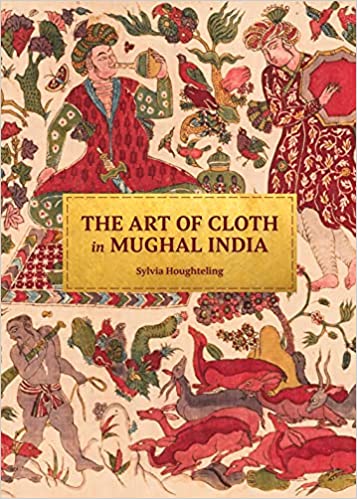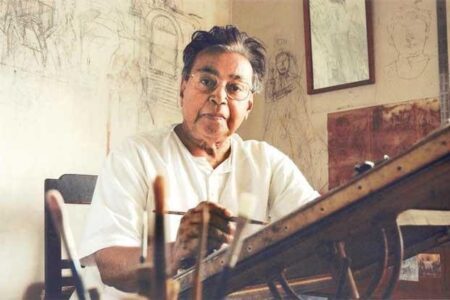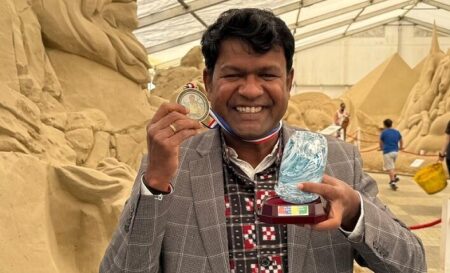French traveller Francos Bernier writes of ‘living flowerbeds’ while describing the use of the Kalamkari work sourced from Machilipatnam in the Mughal rule in India, notes Sylvia Houghteling in her book ‘The Art of Cloth in Mughal India’
In 1665, while accompanying Emperor ʿAlamgir (r. 1658–1707) on a slow-paced overland journey from Delhi to Lahore and onward to Kashmir, French physician and traveler François Bernier had occasion to marvel at the floral fabrics that comprised the emperor’s tent structures. Bernier described the advance team that moved ahead of the imperial entourage with a second, identical set of tents so that the camp would always be in place when the emperor arrived.
One hundred workers leveled the land and erected strong qanāt panels, placed between poles, that formed the physical border of the imperial encampment. The emperor’s largest tent where he engaged in business while on military tour as well as his five other main tents were lined with “beautiful hand-painted chintz [belles Indiennes à fleurs au pinceau], manufactured for the purpose at Maslipatam, the ornamentation of which is set off by rich figured satin of various colors, or embroideries of silk, silver, and gold, with deep and elegant fringes.”
The emperor’s private tents too were “surrounded by small kanates [qanāts], of the height of a man, some lined with Maslipatam chintz” that represented a hundred different kinds of flowers. The blooms on the cloths, Bernier writes, were “so natural and colours so vivid” that the tents they lined seemed to be filled with living flowerbeds (parterre).
Bernier is surprisingly specific about the textiles’ geographic origins. He asserts repeatedly that the painted cotton cloths he witnessed came from “Maslipatam,” a site known also as Masulipatnam and Machilipatnam, that he correctly locates elsewhere in the text as the main port of the Deccan sultanate of Golconda. He attributes the textiles’ fineness not only to the naturalism of the floral patterns but also to the waters around Machilipatnam: “the superior colors of the Maslipatam chittes or cloths, painted by the hand, whose freshness seems to improve by washing, are …ascribed to the water peculiar to that town.”
In these descriptions, Bernier captures not only the visual but the material uniqueness of the region—the colors, forged in the special waters of Machilipatnam, “seem to improve by washing.” Bernier’s description is vivid and frequently quoted.

280 pages; $65.00; Published date (US): 29 March 2022
Within the Hadiqat al-Salātīn, a chronicle written by Nizamuddin Ahmad, a Persian resident in Golconda, we have an earlier account, told from a different perspective, of how Mughal emperors favored Machilipatnam chintz. In a description of Machilipatnam, the chronicle tells how every year, the then-reigning emperor Shah Jahan sent a “trusted person” to “Machlīpatan” to handle the purchase of these same painted cotton cloths that Bernier describes (called qalamkārī in the text).
Nizamuddin Ahmad wrote his account at the end of 1050 Hijri (late 1640 or early 1641 CE), when Shah Jahan had deputized Mirza Sadeq Qazvini, who went by the nickname “Chishro,” to arrange his qalamkārī cloths. Qazvini first visited the sultan of Golconda, who held jurisdiction over the port of Machilipatnam. Golconda was ruled by the Qutb Shah dynasty from their fort in Golconda and nearby capital city of Hyderabad, which lay over two hundred miles inland from Machilipatnam. Qazvini brought with him an official letter (manshūr) filled with kindnesses from the emperor and a ring with rubies that Shah Jahan had taken from his own hand. Because of this valuable gift, he gained much attention at court.
According to Shah Jahan’s decree, Qazvini was then supposed to commission the kalamkari cloth (qalamkārī pārcha) in the same manner as had the previous years’ officials and to use the workers of Machilipatnam to make it. Qazvini himself then traveled from Golconda to Machilipatnam to make sure that this was done.This account suggests a high degree of specificity about Shah Jahan’s patronage of qalamkārī.
It means that he intentionally deputized an imperial official to carry out the commission, that he first had Qazvini deliver a letter and a gift to the rulers of Golconda, and that he desired continuity with the previous year’s product. It also affirms the importance of traveling to the site of production: Mirza Sadeq Qazvini was directed to visit Machilipatnam in order to hire workers from the surrounding area. The way that Nizamuddin Ahmad frames this as an annual task indicates a consistent renewal of cloths for the Mughal emperor.
To my knowledge, this is the first evidence for direct Mughal patronage of qalamkārī and is among the earliest documented uses of the Persian term for cotton cloths painted with mordants and dyed.
As we have seen at the Amber court, “Machilipatnam” cloth was given a high monetary value in inventories. It earned a lover’s appreciation in popular poetry, and it was specifically commissioned by the Mughal emperor on a yearly basis. The designation of “Machilipatnam” as the origin of these cloths actually obscures the fact that the textiles were made in regional villages located along the Krishna and Godavari rivers that lay within one hundred miles of Machilipatnam, including but not limited to Petaboli (Ped-dapalli) and Palicol (Palakollu).
Machilipatnam, a sizable port city with a mid-seventeenth-century population of around 100,000, served as the collecting site and the emporium to purchase cloths destined for the Spice Islands of Southeast Asia, Ottoman and Safavid lands, and onward to Europe. The surroundings of Machilipatnam were far from the only sites that produced high-quality painted cotton textiles, a craft whose reach extended south along India’s eastern coast.
Yet the repeated mentions of this site suggest that something about “Machilipatnam” had a precise significance and cultural cachet in the wider landscape of South Asian textiles—a significance that has typically been overshadowed in the historiography by the global reach of Machilipatnam cloth. This chapter focuses on the period from approximately 1630 to 1690 during which the textile trade in the vicinity of Machilipatnam expanded considerably and a wide array of patrons sought out the “Machilipatnam” cloth.
The textual evidence, along with visual cues, suggests that the individual artisans and workshops engaged in painting cloths for the Amber court, the Mughal emperors, and early European patrons and others may have overlapped and supplied cloths for multiple patrons. While styles of painting do shift over the course of the seventeenth century, subtler details and shared materials also indicate possibilities for continuity.
The recurrence of Machilipatnam in Mughal, Rajput, Deccani, and European records is exciting for the linkages it might establish between what have been thought to have been distinctive, separate strands of practice: the production of cloth for use within Hindustan and the textiles made for export.
In this chapter, I propose further reasons that Machilipatnam cloths hold significance for a history of seventeenth-century textiles: in both their materiality and their visual content, these cloths tell us about the nature of the soil and water, the paths of laborers, and the shape of urban festivities that can only be recognized at a more intimate scale.
Excerpted with permission from Princeton University Press from the book ‘The Art of Cloth in Mughal India’ by Sylvia Houghteling



